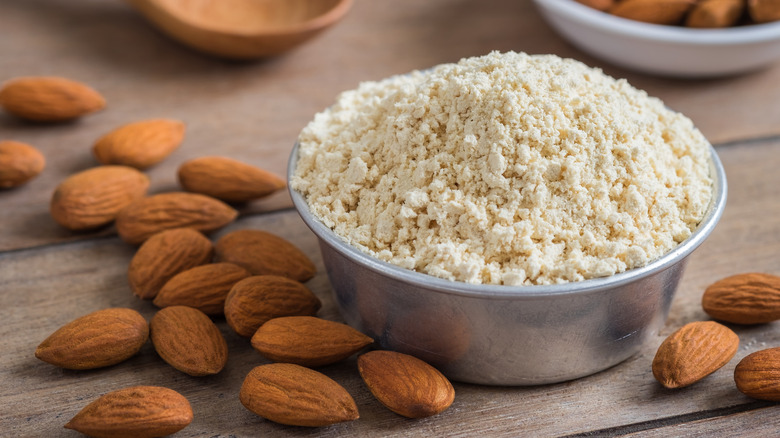A Tip You Should Never Forget When Baking With Almond Flour
Almond flour, the delicious ingredient responsible for the delicate texture of a macaron – as well as the culprit behind macarons' high price – is one of the most popular gluten-free alternatives to typical wheat flours such as all-purpose, enriched, or whole wheat. Although recommendations on substitution ratios differ, with some suggesting a straight one-to-one swap and others recommending using less almond flour than wheat flour, the conversion ratio isn't the only thing to watch out for when baking with almond flour. One tip you should never forget is that almond flour is much higher in fat than regular flour, so adding extra fats could spell disaster for your baking endeavors.
According to the U.S. Department of Agriculture (USDA), regular all-purpose flour is mostly carbohydrates. A 100-gram portion contains 77.3 grams of carbohydrates and 10.9 grams of protein; fat contributes only up to 1.95 grams. Meanwhile, with 50.2 grams of fat per 100 grams, nut-based almond flour is half fat, with 16.2 grams of carbohydrates and 26.6 grams of protein. With almond flour having more than 25 times more fat than regular flour, it's not hard to imagine how adding extra fat might cause an unpleasant oiliness in the final product, potentially introducing unwanted tastes and texture.
Points to ponder
Testing by King Arthur Baking indicates that the fat in almond flour generally behaves similarly to liquid oils: It doesn't help with leavening but makes the baked good softer and more moist. This can be beneficial in dishes known for their moist textures, like cakes and cookies. However, adding additional butter or oil can result in a dense or overly oily finished product. This can be a problem when it comes to baked goods like some breads, where a chewy texture is usually preferred.
Whether you're following a recipe that calls specifically for almond flour, or substituting in a recipe that uses wheat flour, it's important to consider reducing or omitting any additional fats and oils the recipe might call for. A general rule of thumb is to start by reducing the fat in the recipe by 25%. Finding the balance that meets your taste and texture preferences will probably take a bit of trial and error; the brand of almond flour you use might also play a role. You might find that some brands of almond flour advise against using any additional fats; others might still benefit from including a reduced amount of added fats.
Leavener and binders to use with almond flour
However, this isn't to say that you should never add additional fat when you're baking with almond flour. Fat has various roles and ways of interacting with the baking process the different kinds of fats aren't perfectly interchangeable — for example, lard and butter are used in flaky pastries because their solid forms allow for stable aeration, while liquid oils are used in more dense and moist recipes like cakes and brownies. As the fat in almond flour behaves more like liquid oils than solid fats, you might want to still add some butter when making recipes that require extra leavening for a more airy and light texture.
In addition to carefully considering the amount of fat added to the mixture, there are a few other things to keep in mind when adapting a recipe. The main difference between almond flour and regular wheat flour – and a big reason people use it as a substitute — is that almond flour doesn't have any gluten. This can make baking with almond flour tricky, because gluten also plays an important role as a binding agent in many recipes, especially in bread. You'll need to compensate for almond flour's lack of gluten with eggs or xanthan gum to get the texture that you're aiming for.


